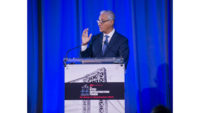Boston Harbor Association Prepares City to Live With Floodwater


Boston is taking preemptive action against chronic, widespread flooding that is expected by the end of the century. On Oct. 29, as part of climate-change preparations, 100 designers and representatives of the city's flood-vulnerable areas will gather for a "living with water" charrette. Also, the city will kick off an international design competition to attract living-with-water flood-management strategies, which allow defined areas to flood or contain water to prevent damage to other areas.
Boston Harbor is protected by natural barriers from the type of storm surge that wreaked havoc in Lower Manhattan and other New York City-area towns during 2012's Superstorm Sandy. But the sea level in Boston, which sits just above the high-tide level, has risen one foot over the past century. Climate scientists project a 2-ft to 6-ft sea-level rise in Boston by 2100. They say that if Sandy's storm surge had peaked at high tide in Boston, the city would have experienced a 100-year flood.
The competition and the living-with-water charrette, both part of the ArchitectureBoston Expo on Oct. 28-30, each seek creative and innovative climate-change-resilient design solutions for three different at-risk waterfront sites in Boston. These include sites of different scales, for example, a historic downtown building, a neighborhood and a site of vulnerable infrastructure. The city, in partnership with the Boston Redevelopment Authority (BRA) and the Boston Harbor Association (BHA), will run the competition, which will be hosted by the Boston Society of Architects.
The contest is funded by an $86,000 grant awarded by the Massachusetts Office of Coastal Zone Management to the BRA and $35,000 awarded by the Barr Foundation to the BHA. Details are available at www.bostonlivingwithwater.org.
Mayor Martin J. Walsh (D) announced the design competition on Aug. 1, in conjunction with the release of the second BHA report on preparing for rising tides. "Designing With Water: Creative Examples From Around the Globe" offers urban design solutions—at different scales—to deal with sea-level rise.
The 73-page report, which cost $50,000, follows BHA's $70,000 report, "Preparing for the Rising Tide," released last year. The first study maps the area's vulnerabilities. Both are available at www.tbha.org/climate-change-adaptation.
The reports, funded by the Barr Foundation, are not applicable only to Boston. "It was purposeful that both reports be relevant to Boston but useful elsewhere," says Julie Wormser, BHA's executive director.
The goal is to find ways to design or retrofit buildings, neighborhoods and cities to be able to live with floodwater, rather than "armoring ourselves" to keep out all the water, says Jason Hellendrung, a principal with design firm Sasaki Associates, which co-authored the latest report.
The report provides 12 case studies that show how living-with-water strategies allow cities all over the world to decrease potential flood damage without damaging the community. The projects were picked based on five designing-with-water principles: design for resilience; create double-duty solutions that provide multiple benefits; strengthen community resilience to maintain cultural identity; incentivize and institutionalize preparedness; and phase plans over time.
The case studies include successful design projects, such as floating apartment buildings, canals, floodable first floors and flood-prone urban open spaces. The emphasis is on beautiful solutions, not just protection. "Boston has to be different but not ugly," says Wormser.
BHA expects to create a preparedness scorecard in its next report, due out in about a year. "We need to know if our investments work well," says Wormser.






